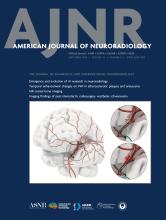Index by author
September 01, 2024; Volume 45,Issue 9
Chen, Hui
- Artificial IntelligenceYou have accessAssessing the Performance of Artificial Intelligence Models: Insights from the American Society of Functional Neuroradiology Artificial Intelligence CompetitionBin Jiang, Burak B. Ozkara, Guangming Zhu, Derek Boothroyd, Jason W. Allen, Daniel P. Barboriak, Peter Chang, Cynthia Chan, Ruchir Chaudhari, Hui Chen, Anjeza Chukus, Victoria Ding, David Douglas, Christopher G. Filippi, Adam E. Flanders, Ryan Godwin, Syed Hashmi, Christopher Hess, Kevin Hsu, Yvonne W. Lui, Joseph A. Maldjian, Patrik Michel, Sahil S. Nalawade, Vishal Patel, Prashant Raghavan, Haris I. Sair, Jody Tanabe, Kirk Welker, Christopher T. Whitlow, Greg Zaharchuk and Max WintermarkAmerican Journal of Neuroradiology September 2024, 45 (9) 1276-1283; DOI: https://doi.org/10.3174/ajnr.A8317
Chen, James Y.
- Health Policies/Quality Improvement/Evidence-Based NeuroimagingYou have accessAnalysis of Requirements within Neuroradiology Job Advertisements in a Specific TimeframeVishal D. Thumar and James Y. ChenAmerican Journal of Neuroradiology September 2024, 45 (9) 1202-1205; DOI: https://doi.org/10.3174/ajnr.A8373
Chen, Yasheng
- EDITOR'S CHOICEArtificial IntelligenceYou have accessMR Cranial Bone Imaging: Evaluation of Both Motion-Corrected and Automated Deep Learning Pseudo-CT Estimated MR ImagesAndrew D. Linkugel, Tongyao Wang, Parna Eshraghi Boroojeni, Cihat Eldeniz, Yasheng Chen, Gary B. Skolnick, Paul K. Commean, Corinne M. Merrill, Jennifer M. Strahle, Manu S. Goyal, Hongyu An and Kamlesh B. PatelAmerican Journal of Neuroradiology September 2024, 45 (9) 1284-1290; DOI: https://doi.org/10.3174/ajnr.A8335
In this study, the authors developed automated motion correction and used deep learning to generate pseudo-CT cranial images from MR images. Compared with CT, pseudo-CT had 100% specificity and 100% sensitivity for suture closure and 100% specificity and 90% sensitivity for skull fractures.
Cho, Se Jin
- Artificial IntelligenceYou have accessAutomated Detection of Steno-Occlusive Lesion on Time-of-Flight MR Angiography: An Observer Performance StudyHunjong Lim, Dongjun Choi, Leonard Sunwoo, Jae Hyeop Jung, Sung Hyun Baik, Se Jin Cho, Jinhee Jang, Tackeun Kim and Kyong Joon LeeAmerican Journal of Neuroradiology September 2024, 45 (9) 1253-1259; DOI: https://doi.org/10.3174/ajnr.A8334
Choi, Dongjun
- Artificial IntelligenceYou have accessAutomated Detection of Steno-Occlusive Lesion on Time-of-Flight MR Angiography: An Observer Performance StudyHunjong Lim, Dongjun Choi, Leonard Sunwoo, Jae Hyeop Jung, Sung Hyun Baik, Se Jin Cho, Jinhee Jang, Tackeun Kim and Kyong Joon LeeAmerican Journal of Neuroradiology September 2024, 45 (9) 1253-1259; DOI: https://doi.org/10.3174/ajnr.A8334
Christoforidis, Gregory
- NeurovascularYou have accessEfficacy Assessment of Cerebral Perfusion Augmentation through Functional Connectivity in an Acute Canine Stroke ModelChisondi S. Warioba, Mira Liu, Sagada Peñano, Timothy J. Carroll, Sean Foxley and Gregory ChristoforidisAmerican Journal of Neuroradiology September 2024, 45 (9) 1214-1219; DOI: https://doi.org/10.3174/ajnr.A8320
Chukus, Anjeza
- Artificial IntelligenceYou have accessAssessing the Performance of Artificial Intelligence Models: Insights from the American Society of Functional Neuroradiology Artificial Intelligence CompetitionBin Jiang, Burak B. Ozkara, Guangming Zhu, Derek Boothroyd, Jason W. Allen, Daniel P. Barboriak, Peter Chang, Cynthia Chan, Ruchir Chaudhari, Hui Chen, Anjeza Chukus, Victoria Ding, David Douglas, Christopher G. Filippi, Adam E. Flanders, Ryan Godwin, Syed Hashmi, Christopher Hess, Kevin Hsu, Yvonne W. Lui, Joseph A. Maldjian, Patrik Michel, Sahil S. Nalawade, Vishal Patel, Prashant Raghavan, Haris I. Sair, Jody Tanabe, Kirk Welker, Christopher T. Whitlow, Greg Zaharchuk and Max WintermarkAmerican Journal of Neuroradiology September 2024, 45 (9) 1276-1283; DOI: https://doi.org/10.3174/ajnr.A8317
Clancy, Marianne S.
- Pediatric NeuroimagingYou have accessCurrent Practice: Rationale for Screening Children with Hereditary Hemorrhagic Telangiectasia for Brain Vascular MalformationsLauren A. Beslow, Andrew J. White, Timo Krings, Adrienne M. Hammill, Shih Shan Lang, Atsuko Baba, Marianne S. Clancy, Scott E. Olitsky and Steven W. HettsAmerican Journal of Neuroradiology September 2024, 45 (9) 1177-1184; DOI: https://doi.org/10.3174/ajnr.A8195
Colen, Rivka R.
- Brain Tumor ImagingYou have accessSex-Specific Differences in Patients with IDH1–Wild-Type Grade 4 Glioma in the ReSPOND ConsortiumSree Gongala, Jose A. Garcia, Nisha Korakavi, Nirav Patil, Hamed Akbari, Andrew Sloan, Jill S. Barnholtz-Sloan, Jessie Sun, Brent Griffith, Laila M. Poisson, Thomas C. Booth, Rajan Jain, Suyash Mohan, MacLean P. Nasralla, Spyridon Bakas, Charit Tippareddy, Josep Puig, Joshua D. Palmer, Wenyin Shi, Rivka R. Colen, Aristeidis Sotiras, Sung Soo Ahn, Yae Won Park, Christos Davatzikos, Chaitra Badve and on behalf of the ReSPOND ConsortiumAmerican Journal of Neuroradiology September 2024, 45 (9) 1299-1307; DOI: https://doi.org/10.3174/ajnr.A8319
Commean, Paul K.
- EDITOR'S CHOICEArtificial IntelligenceYou have accessMR Cranial Bone Imaging: Evaluation of Both Motion-Corrected and Automated Deep Learning Pseudo-CT Estimated MR ImagesAndrew D. Linkugel, Tongyao Wang, Parna Eshraghi Boroojeni, Cihat Eldeniz, Yasheng Chen, Gary B. Skolnick, Paul K. Commean, Corinne M. Merrill, Jennifer M. Strahle, Manu S. Goyal, Hongyu An and Kamlesh B. PatelAmerican Journal of Neuroradiology September 2024, 45 (9) 1284-1290; DOI: https://doi.org/10.3174/ajnr.A8335
In this study, the authors developed automated motion correction and used deep learning to generate pseudo-CT cranial images from MR images. Compared with CT, pseudo-CT had 100% specificity and 100% sensitivity for suture closure and 100% specificity and 90% sensitivity for skull fractures.
In this issue
American Journal of Neuroradiology
Vol. 45, Issue 9
1 Sep 2024
Advertisement
Advertisement








